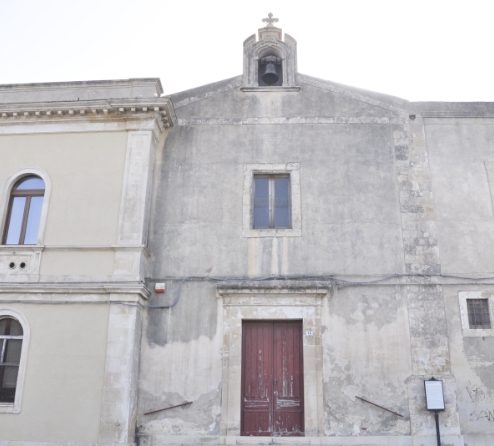Church of the Holy Cross
1693-first half 18th century
From July 30th to August 15th, open only on Sundays at 6:00 PM until the end of the mass.
The assent to found the Capuchin Convent in “Antiqua Abola” and the Church of the Holy Cross was given in 1579 by the Provincial Chapter of the Order. Their building began in 1580 thanks to the people and Maria de Marinis’s will. Maria was John II of Aragon Tagliavia’s widow and the guardian of her son Carlo junior, heir of the Marquisate of Avola. The buildings were constructed “around two hundred paces” outside the city on the king’s road that linked the city with other towns in the Hyblaean plateau.
After the earthquake of 1693, the Hermitage of Saint Mary of the Graces was built on their ruins. In the new city the Franciscan monastery was located in an isolated position towards the north-west, outside the city centre with its hexagonal perimeter designed by Angelo Italia. The church was built with rigorous simplicity, facing onto a broad area used for fairs and initially called the “Capuchin” area, and later Piazza F. Crispi. The church has a nave with chapels for the nobility on the right-hand side.

It was a burial site until the mid-19th century. The wooden structure of the main altar is beautifully made and worthy of note. On the holy altar is the majestic Ciborium made by the Capuchin friar Giuseppe da Ragusa (1610-1673) in the old monastery, between 1667 and 1670. The skilled friar realized it, with precious woods, on three orders with a bulb-shaped dome on top. The component architectural elements are decorated in inlay and relief: in baroque style, but renaissance in the setting, they highlight heads of caryatids and, in the friezes and on the spiral columns, twigs of plants. Five statues, purchased in Palermo in 1692, adorned the niches until 1984. Above the altar is the polyptych with the majestic central frame also made by Friar Giuseppe to adorn the Exaltation of the Holy Cross: a fine late sixteenth-century painting attributed (R. Cannatà) to the Flemish painter Franz van de Kasteele, who worked in Rome under the Italianised name Francesco da Castello.
The painting is a complex one, based on a drawing by the French artist Nicolas Béatrizet of 1557. The Holy Cross is in a central position, flanked on the sides by twelve figures in worship. To the left of the spectator, in the background, are the saints Radegund, Paula of Rome and Helen; in the foreground Catherine of Alexandria, Mary Magdalene and the Virgin Mary. On the right are the saints Constantine, Hugh of Lincoln, Louis IX of France, Paul, Jerome and Peter, with keys and papal vestments. The two side cornices of the polyptych contain the sumptuously Baroque paintings of Saint Venera and Saint Lucy; the rectangles below contain the portraits of Saint Francis and Saint Conrad.
The chapels house the Ecstasy of Saint Francis, painted in 1706 by Giuseppe Sequenzia of Noto, Saint Felix of Cantalice and the Annunciation. On the left-hand wall of the nave is the 18thcentury painting of Saint Vitus, attributable to Costantino Carasi. The monastery was closed in 1866 and purchased in 1877 by the Municipality of Avola, for use as a Hospice/Hospital. The church remained in use because considered particularly holy and because of its great artistic value.

Explore the historic center of Avola!
Welcome to Avola, the hexagonal city! Explore the historic center.
Explore the historic center of Avola!
Welcome to Avola, the hexagonal city! Explore the historic center.
